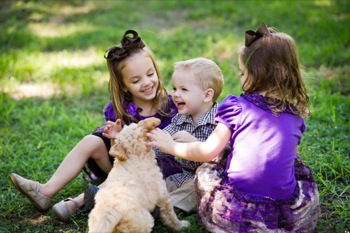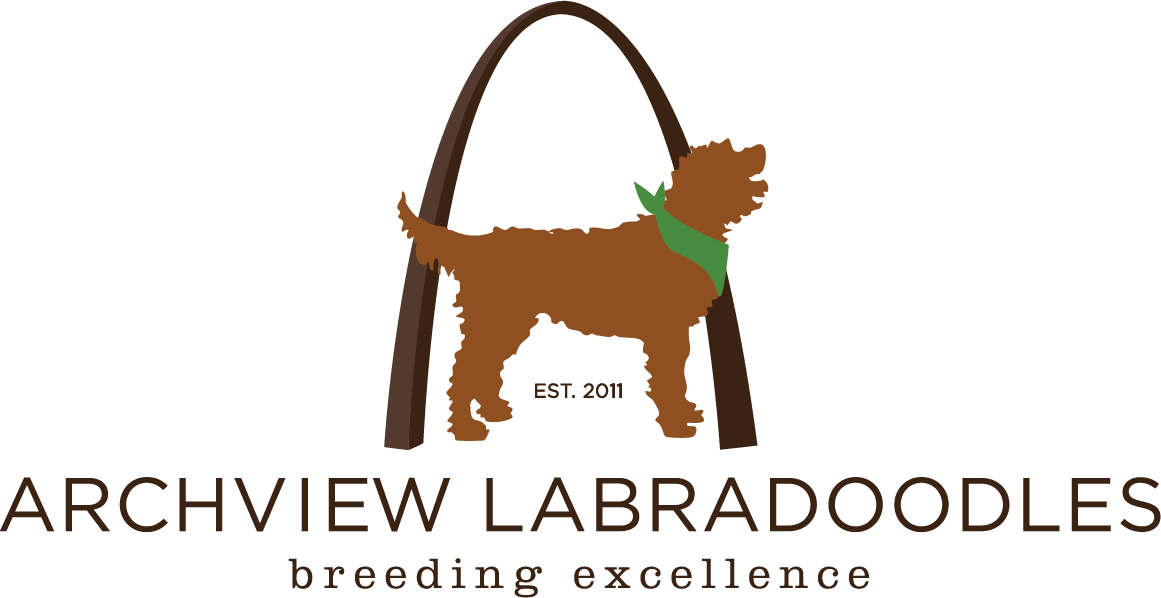 Okay! So you have decided to get a puppy! It’s time to get prepared NOW so that when the pup arrives you can focus on the puppy and not all the “crazy details”.
Okay! So you have decided to get a puppy! It’s time to get prepared NOW so that when the pup arrives you can focus on the puppy and not all the “crazy details”.
There are seven sections of preparation:
- Professional Services and Supplies
- Equipment and Supplies
- Treats, Food and Toys
- Rally the Family
- Prepare the House
- First Few Days Help
- Reading
Professional Services
Identify a Veterinarian to provide on-going medical care
Identify an emergency Veterinarian
Identify your local poison control center
Identify a good doodle friendly training facility
Identify a dog walker, if needed
Identify a doggie daycare, if needed
Identify a reputable animal behaviorist, if needed
Identify a doodle friendly groomer
Explanation: The initial Veterinarian visit should occur 2-3 days after the puppy’s arrival. It is also important to identify the closest emergency veterinarian in the event that your puppy needs immediate care at night or on the weekends when your regular vet is not available. Learn where the emergency vet is located BEFORE there is an emergency. Post your local poison control center phone number near your phone. If you are going to be leaving for long periods of time (such as work) you will need to make arrangements with someone to come in and take the puppy out for a walk and potty break. Start doing your homework now on locating a good trainer and talk to them about a puppy socialization class. Doggie daycare, animal behaviorist and groomer are professionals that you may or may not elect to use, but knowing who is reputable in your area will be useful if you find you do need their services. Do the research now, so that you can devote your time to raising the puppy.
Hydrogen Peroxide or Ipecac Syrup
Pepto Bysmol (Liquid form)
Thermometer
Needle-less Syringe
Ear Cleaner & Cotton Balls
Nail Clipper (Heavy Duty) and Styptic
Greyhound Comb (Available online at Pet Edge)
Dog Shampoo (We Prefer Puppy Tears by Kelco)
Grooming Scissors
Toothbrush & Cleaner
Water and food bowls (stainless steel bowls recommended)
Explanation: Hydrogen Peroxide or Ipecac Syrup can be used in the event that your dog has swallowed something dangerous. Be sure to check with a medical professional prior to administering either product to assure that it is the best and safest solution. It is also helpful to have some pepto on hand for those times when the doodle has an upset stomach. If you suspect that your doodle is sick, having a thermometer on hand will be helpful to determine if he has a fever (A dog’s normal body temperature is between 101°F and 102°). Fevers can be a symptom of an infection. Having a needle-less syringe is an excellent way to administer liquid to a dog – your dog supply kit should have several of these on hand. You can obtain these needle-less syringes from your Vet. Doodles will need to have their ears, teeth cleaned and their nails trimmed on a regular basis. It is good to get a puppy comfortable with all these activities starting at an early age. If you trim a nail too close, the styptic will stop the bleeding.
Brushes and combs will be needed to keep their coats health and free of mats and smell. Although a puppy should not be bathed too often, be sure to use a mild shampoo specifically for dogs – always rinse shampoo completely. Every doodle owner should have a good pair of scissors to do quick trims around the bridge of the nose, between paw pads and to remove tough mats.
Good Hint: Place all supplies in a containers (one for Medical and one for Grooming) with a lid. Mark the containers and make it a habit to return all items to the container. Replenish the supplies as they are used. Keep all items together and in a specific place.
Reading/Reference Guide:
Caring For Your Dog – The Complete Canine Home Reference – Author: Bruce Fogle, DVM (Book)
Crate- (We Prefer Wire Crates with a divider that can grow with your Puppy)
Puppy Exercise Pen and/or Baby Gates
Collar with ID and Contact Number
Leash (4 or 6 feet long)
Long Line Leash (10 – 20 feet long)
Paper Towels – Several rolls
Cleaner – urine neutralizing (Natures Miracle or Simple Solution)
Plastic bags (grocery store bags work fine)
Explanation: Standard Doodle usually will need a 42” – most owners and doodles prefer the wire crates. Be sure to select one of strong metal and the door(s) should have two latches – not just one in the center. Baby gates and exercise pens are wonderful to use to control the areas your puppy can go inside and outside. Keeping their areas small to start with will benefit the puppy in training.
Be sure that the Collar has your dogs name and a contact number directly on the collar – have it sewn on or use a permanent marker – ID tags can often break off. You will most likely utilize three different sizes of collars as the doodle matures. Collars that have a quick attach/release work best because you will need to be able to put on and remove easily (doodle should not have a collar on while inside their crate).
There are many options on leashes – word to the wise, avoid getting a leather leash until the pup matures. Leather is wonderful to chew on so wait on them until after you have taught the pup to not mouth or bite the leash. Leashes with traffic handles are also great to assist in keeping your dog close – but they are often more helpful after the puppy has grown up a bit. Long line leashes are useful when you want to allow the puppy to do a bit of running and you don’t have a place he can run freely. The long line is also a great tool when you are teaching your doodle to “come”.
Paper towels, cleaner and plastic bags will help you clean up accidents. You can never have too many of these three things and you will find that have several different locations with these cleaning items will be a great benefit. Even consider keeping them in your car in the event you have your dog out and about and he needs to go potty.
Kongs (puppy size)
Balls (various sizes)
Interactive Toys
Fetch Toys
Chew Bones
Soft Training Treats
Crunchy Biscuits
Bully Sticks
Starch Bones (Corn or Rice)
Large Container of Peanut Butter (Marked for Dog Only)
Cans of pure pumpkin (not pie mix); couple of tablespoons will help with loose or too firm stools.
Training treat bag for hands free and quick access to treats
Water and food bowls (stainless steel recommended)
A supply of breeder recommended puppy food
Don’ts:
No laser pointers! They can be dangerous to the dogs’ eyes and some dogs can also develop an obsession of chasing lights and shadows.
No rawhide or pigs ears. They both have high choking risk even if you are supervising. They are high in fat and will become slippery – which is almost impossible to reach in and grab to pull out. In addition, they will frequently cause diarrhea.
Don’t over play with balls to avoid an obsession.
Tennis balls outer fuzz can become a problem for some dogs’ teeth – they can wear out the enamel. Either reduce the amount of tennis ball time or select balls that do not have the fuzz.
Waste of Time Items:
Dog beds – will be treated like a giant chew toy for most dogs. Most doodles actually prefer to sleep on a hard surface.
Expensive plush stuff toys – run to the local resale shop and get some of the used stuffed animals instead (remove risky parts, ribbons, sewn on eyes…etc.)
Discussing the “rules of the house” with all family members should be done prior to bringing home the puppy. Make sure that everyone is consistent with the training and procedures. If the rules change daily or each family member has a different set of rules, the dogs ability to do what is “right” will become almost impossible.
Determine where will the puppy sleep
Decide who, when and where the puppy will be fed
Identify where the puppy’s potty spot be
Establish where the puppy will stay during the day
Determine the “off limits” area of the house for the puppy
Select who will provide the formal training
Have a clear understanding on how to correct the puppy
Work with the children NOW about proper handling and playing with a puppy
Don’t allow children to play inside crate – ever
Get to know what foods are toxic to dogs
Start getting in the habit of picking up clothes, shoes, toys or valuable items and put away
Tidbit: One of the primary items that a dog will chew up and swallow is: underwear.
Reading/Reference Guide:
Raising Puppies & Kids Together – A Guide for Parents
Authors: Pia Silvani, CPDT and Lynn Eckhardt
Outside
If you have a fence – walk it and check to make sure that it does not have any gaps or holes where a puppy could crawl under
Secure all doors and gates – locks preferable
Identify your puppy’s potty spot and the door you will use to take the puppy out to potty
If you have high decks – make sure the puppy can not fall from the deck
Block stairs so puppy will not be able to run up and down them until he is fully developed
Do a plant check (see the Toxic plant listing)
If you have decorative rocks – either remove or cover or never allow doodle around them unsupervised
Check yard for cat “litter boxes” – make note of those areas and do not permit your doodle to go into those areas to eat “snacks”
Have a bucket or water container for your puppy to get a drink. Refresh water often
Make sure that lawn care products are not toxic to the puppy
Make sure that cars do not have antifreeze leaking
Check garage for toxic products and move out of harms way
Check all the cars for items that could be chewed on or swallowed
Good Hint: Most yards in the United States have yew bushes, they are as common as maple trees. They are toxic! Many dogs will not mouth them when older because they taste awful (which is why we rarely hear about them being toxic), but to a puppy the desire to play is much greater and can ingest. Either remove or mark the plants with a red marking tape to remind you to keep the pup away from them.
Inside
Remove items from end tables, coffee tables and eye level display shelves
Store remote controls in drawers or keep up high away from the puppy
Move litter box and cat food to an area where the puppy cannot get into it
Make power cords inaccessible
Block off stairs and rooms you don’t want the puppy free access to
Clear off counter tops in kitchen
Secure all cleaning products away from the puppy
Remove area rugs (will become a potty spot target)
Move irreplaceable furniture into another room for while
Remove decorative rocks from plant pots
Move coin storage to an inaccessible area
Removed decorative pillows (will get mistaken for a toy)
Make sure that plug in air fresheners are not accessible
Check your bathrooms secure trash away, close lid to toilet consider moving toilet paper up out of reach
Good Hint: Get a laundry hamper for toys. It has a lid and airflow holes, which permits the air to travel around the toys and avoids musty smells.
Ticking Clock or; Snuggle Puppy (heated and with a beating heart sound) or; Radio
Boxes – cardboard or plastic to reduce crate down to a square (See Crate Set-up information)
You can never read too much when it comes to preparing for the arrival of your puppy. There are many books with many different ideas and perspectives. Read as much as possible and utilize the things that work for your family.
If you could only get three books these are the three that will be the most critical and beneficial
Caring For Your Dog – The Complete Canine Home Reference
Author: Bruce Fogle, DVM (Book)
Raising Puppies & Kids Together – A Guide for Parents
Authors: Pia Silvani, CPDT and Lynn Eckhardt
The Perfect Puppy in 7 Days
Author: Sophia Yin
Information used with permission from International Doodle Owners Group.






